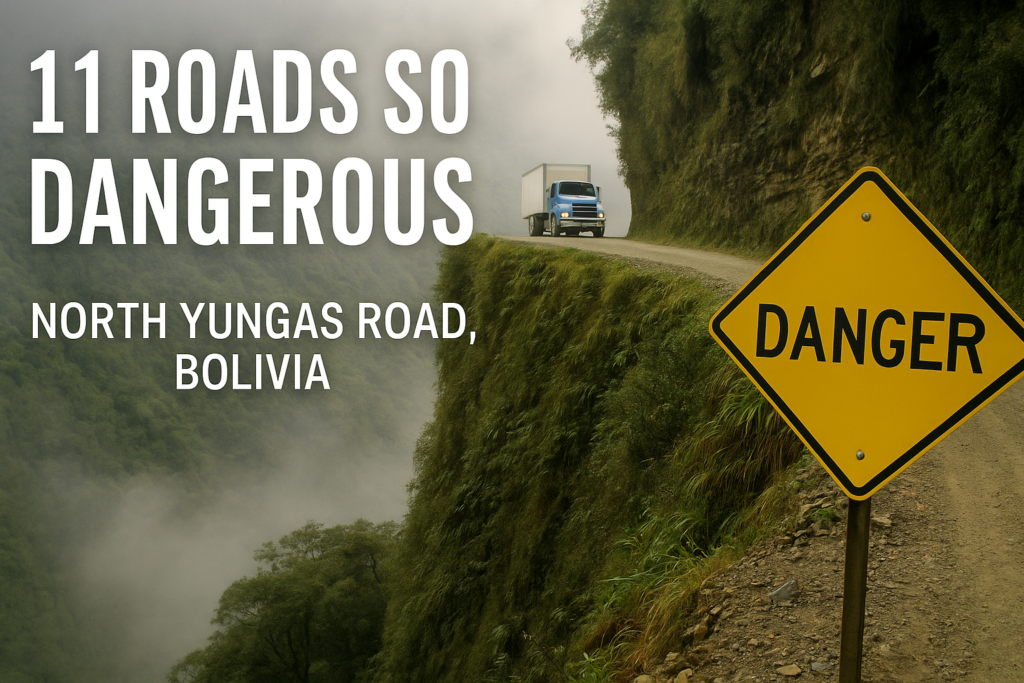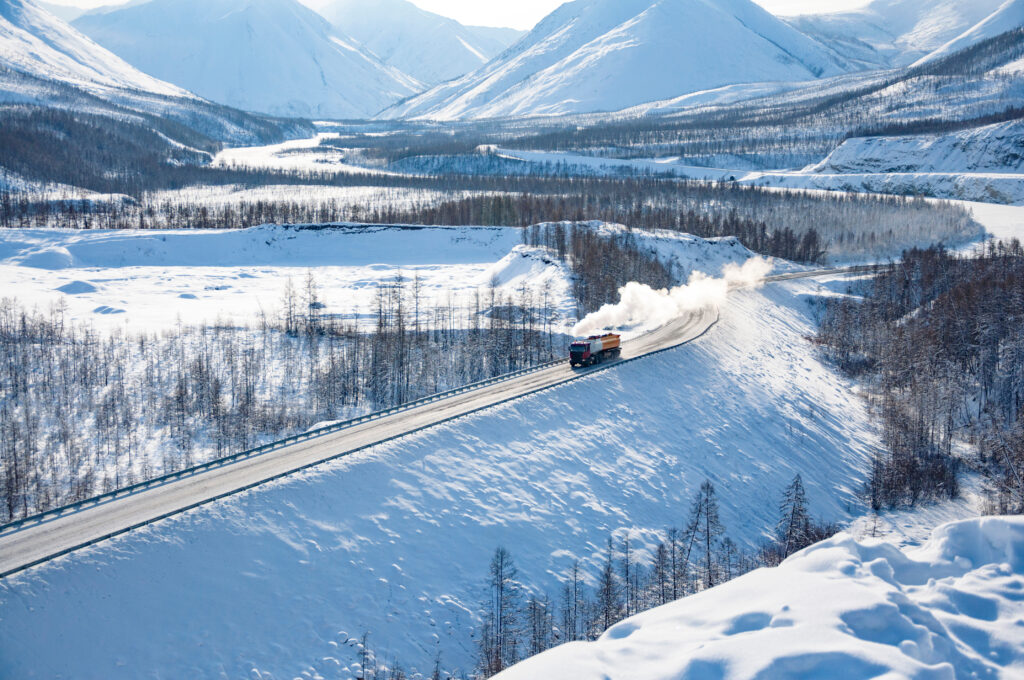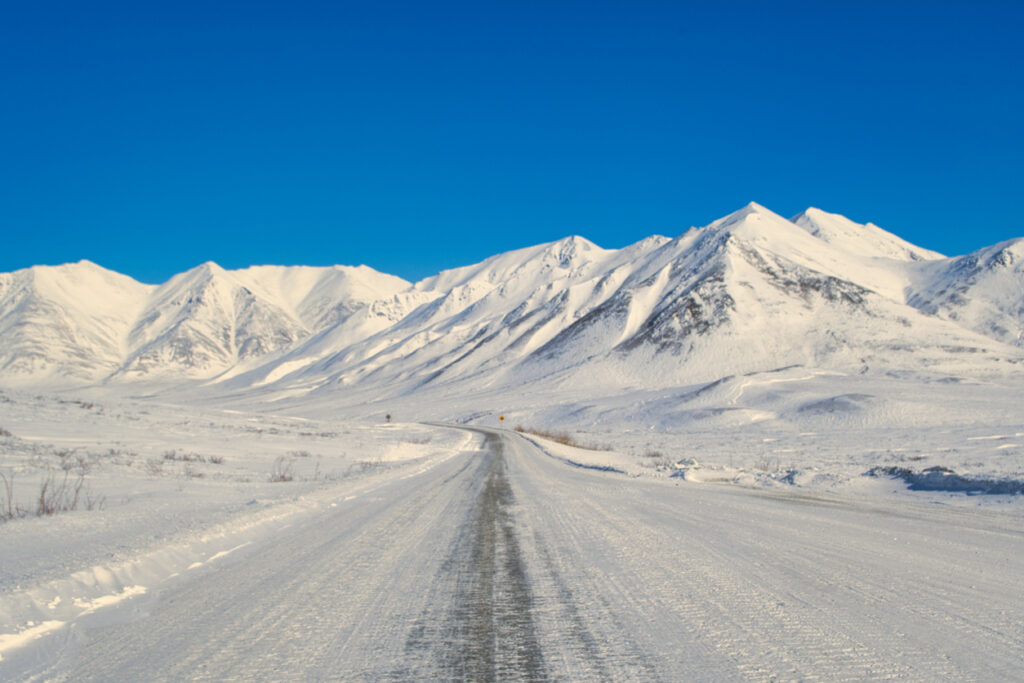1. North Yungas Road, Bolivia

Nicknamed “Death Road” for good reason, Bolivia’s North Yungas Road has claimed thousands of lives, and it’s still open to traffic. This 40-mile stretch of narrow, winding dirt clings to cliffsides with drops of over 2,000 feet and barely a guardrail in sight. Carved into the edge of the Andes, it’s often shrouded in fog or hit by sudden downpours, which turn the path slick and visibility to zero. Two vehicles can barely pass, yet trucks, buses, and daredevil cyclists attempt it daily. Add falling rocks and landslides, and you’ve got yourself a white-knuckle ride straight into a canyon.
Even locals who’ve grown up with it avoid it when they can, opting for newer routes or public transport that cuts the risk. In its most dangerous years, the road was blamed for 200–300 deaths annually. Today, it’s become something of an extreme tourism bucket list item, but locals will tell you: it’s not the kind of road you take twice. Whether you’re behind the wheel or on a bike, one wrong move is all it takes to make the nickname real. Source: BBC Travel – Death Road in Bolivia
2. Kolyma Highway, Russia (The Road of Bones)

Stretching over 1,200 miles through remote eastern Siberia, the Kolyma Highway, better known as the Road of Bones, is a frozen gauntlet of isolation and death. Built by prisoners of Stalin’s gulags in the 1930s and ’40s, the road earned its name because the bones of those who died during its construction were used as fill beneath the pavement. Temperatures along the route can drop to -90°F, and in winter, entire vehicles can freeze solid if left unheated for even a few minutes. In summer, permafrost melt transforms the gravel road into a sludge-filled trap of mud, ice, and crumbling edges.
Most of the highway cuts through sparsely inhabited tundra, meaning if something goes wrong, a flat tire, mechanical failure, or sliding off the edge, you’re completely on your own. Emergency services are minimal to nonexistent, and even truckers carry survival kits for days of isolation. Locals avoid the route whenever possible, relying on air travel or sticking close to cities like Magadan and Yakutsk. Driving the Road of Bones isn’t just about nerves, it’s about whether your vehicle, your provisions, and your luck can survive the coldest inhabited place on Earth. Source: PH Museum – Siberia’s Road of Bones
3. Zoji La Pass, India

Connecting the Kashmir Valley to the stark region of Ladakh, Zoji La Pass winds through the Himalayas at over 11,500 feet above sea level. It’s barely more than a carved-out gravel shelf hanging off the side of a mountain, narrow, steep, and flanked by sheer drops. There’s no barrier between your tires and oblivion, and yet trucks, jeeps, and even motorcycles attempt it daily. Snowfall can block the road for half the year, and even in summer, landslides, sudden storms, and zero-visibility fog can turn the journey into a cliffside roulette.
The road is so dangerous that many locals time their crossing with military convoys or experienced drivers, and even they’ll tell you: it’s not a matter of if your vehicle will slip, it’s when. Cars often get stuck in the mud, or stalled in traffic on hairpin turns with inches between bumpers and the edge. And if you’re unlucky enough to face oncoming traffic? Someone has to reverse, blind, uphill, and hug the cliff. Source: India Times – Most Dangerous Mountain Passes in India
4. Kahekili Highway, Maui, Hawaii

Don’t let the tropical postcard setting fool you, Kahekili Highway is one of the most terrifying stretches of pavement in the United States. Also known as Hawaii Route 340, this coastal cliff-hugging road on Maui’s northwestern edge features single-lane sections so narrow, locals joke that you have to fold in your mirrors and your fear. With no guardrails and sheer drops straight into the Pacific, the road winds around blind curves carved directly into volcanic rock. It’s a test of reflexes, trust, and brake pads, especially when you encounter an oncoming vehicle with nowhere to pass.
Many rental car companies explicitly advise visitors not to attempt this route, and even longtime Maui residents will admit they avoid it when they can. Rain turns the road slick, falling rocks are common, and cell service is spotty at best. Still, thrill-seeking drivers keep trying to “conquer” it for the views, often white-knuckling their way around cliff bends they instantly regret. It’s a beautiful drive… if you survive it. Source: Conde Nast Traveler – World’s Scariest Roads
5. James W. Dalton Highway, Alaska, USA

Built as a supply route for the Trans-Alaska Pipeline, the James W. Dalton Highway is a 414-mile stretch of isolation that cuts through some of the most unforgiving terrain in North America. From Fairbanks to Deadhorse near the Arctic Ocean, the road is mostly gravel, flanked by permafrost, high winds, and temperatures that regularly plunge below -40°F. There are only three towns along the entire route, none with more than a few dozen residents. Gas stations are 240 miles apart. Cell service? Forget it.
Even truckers, who are the road’s primary users, treat it with caution. Ice fog blinds windshields, grizzly bears cross at will, and the road itself has been known to collapse due to melting permafrost. A single wrong move could mean sliding into a ditch with no hope of help for hours or days. Locals in Fairbanks know the risks and rarely venture far up the Dalton without serious supplies. In winter, it’s less a road and more a dare. Source: Alaska Department of Transportation – Dalton Highway Overview
6. Guoliang Tunnel Road, China

Carved by hand into the side of a vertical cliff by 13 villagers in the 1970s, the Guoliang Tunnel Road in China’s Taihang Mountains is equal parts engineering marvel and nightmare fuel. The tunnel itself is only about 0.75 miles long, but it’s what surrounds it, chiseled stone windows opening to dizzying drops, rockfall hazards, and a single-lane width, that makes even locals hesitate before driving through. There’s no real shoulder, no guardrail, and plenty of blind corners with nothing but air on the other side.
Located in Henan Province, the road connects the remote village of Guoliang to the outside world, and while tourism has brought more attention, it hasn’t made the drive any safer. Rain makes the surface slick, while snow or ice render it practically impassable. Residents still rely on it for transport, but they do so with white knuckles and good reason. If you meet another car mid-tunnel, good luck, backing up on a cliff edge isn’t for the faint of heart. Source: CNN Travel – World’s Most Dangerous Roads
7. Skippers Canyon Road, New Zealand

Skippers Canyon Road near Queenstown may offer jaw-dropping views, but driving it requires nerves of steel and a very narrow vehicle. This unpaved, cliff-hugging trail winds through steep canyons carved by the Shotover River, with no guardrails and barely enough width for a single car. The road is so treacherous that rental car companies specifically ban driving on it, and they won’t cover insurance if you do. That hasn’t stopped adventure-seekers, but locals familiar with its blind turns and crumbling edges often choose safer alternatives.
Originally built during the 1800s gold rush, the road hasn’t changed much, except maybe for the increased number of warning signs. Falling rocks, sudden washouts, and steep drop-offs make passing oncoming traffic a game of reverse chicken. The road is still used for scenic tours and thrill-seeking detours, but even Queenstown drivers will tell you: if the weather turns or your brakes fail, you’re out of luck, and possibly off the road. Source: New Zealand Transport Agency – Skippers Canyon Travel Advisory
8. Atlantic Ocean Road, Norway

At first glance, Norway’s Atlantic Ocean Road looks like something out of a luxury car commercial, smooth asphalt stretching across a string of islands, with sweeping curves and a view of the open sea. But when the weather turns (and it does often), this scenic drive becomes a storm-battered gauntlet. Built just above sea level, the road is notorious for massive waves that crash directly over the asphalt, sometimes completely obscuring the view and even sweeping cars off the road. High winds, sudden squalls, and black ice only add to the danger.
Locals are well aware of its mood swings and time their drives with forecasts, avoiding it entirely when winter storms roll in. During especially rough weather, even experienced commercial drivers stay away, letting the ocean have its tantrum. Though it’s a marvel of engineering and a beloved tourist route, the Atlantic Ocean Road is not one to take lightly. When it’s calm, it’s jaw-droppingly beautiful. When it’s angry, it’s a car wash with consequences. Source: Visit Norway – Atlantic Ocean Road Travel Info
9. Taroko Gorge Road, Taiwan

Cut through sheer marble cliffs in Taiwan’s Central Mountain Range, Taroko Gorge Road is a dramatic, narrow stretch of highway where drivers battle gravity, weather, and crumbling rock faces. Known officially as the Central Cross-Island Highway, this winding road is notorious for frequent landslides, blind hairpin turns, and tunnels so tight they barely accommodate a car. The cliffs above often weep water onto the road, loosening debris and turning rockfall into a regular hazard. And when typhoon season hits? It’s often closed for good reason.
Even locals who know its curves inside and out tread carefully here. Emergency repair crews are on constant standby, and tour buses must navigate turns so tight they often need to reverse mid-route. It’s not uncommon for one section to be clear while another is entirely washed out just around the bend. Tourists come for the views, but even many Taiwanese drivers opt for alternate routes unless necessary. Source: Taiwan Tourism Bureau – Taroko National Park Safety Notices
10. Fairy Meadows Road, Pakistan

The road to Fairy Meadows in Pakistan is anything but a fairytale. Often dubbed one of the most dangerous roads in the world, this unpaved mountain trail climbs nearly 10,000 feet into the Himalayas, with no guardrails, no pavement, and no forgiveness. It’s just over six miles long, but that’s more than enough to push drivers to the edge, literally. The path is carved into the side of a sheer cliff, wide enough for only one jeep at a time, with vertical drops of hundreds of feet. One bad turn or loose rock, and you’re airborne.
Local drivers with years of experience handle the treacherous terrain using specially modified jeeps, but even they avoid it during rain or snow. Rockslides, fog, and loose gravel are everyday obstacles, and tourists are strongly discouraged from attempting the drive themselves. Most visitors opt to hike the final stretch after riding up partway. For many locals, it’s a road of necessity, but not one taken lightly. Source: Dangerous Roads – Fairy Meadows Track
11. Passo dello Stelvio, Italy

With 48 tight switchbacks stacked up the side of the Alps, Italy’s Passo dello Stelvio is one of Europe’s most iconic and intimidating drives. Rising to 9,045 feet above sea level, this mountain pass twists like a snake on espresso, with sharp turns so tight drivers often have to crank the wheel hand-over-hand just to stay on the road. Add in steep drop-offs, narrow lanes, and tour buses that take up more than their share, and you’ve got yourself a white-knuckle ride even locals won’t casually attempt, especially in winter.
Though it’s been called one of the greatest driving roads in the world, Stelvio’s beauty comes with a cost. Fog rolls in without warning. Cyclists crowd the road during summer. Snow clings to the curves well into spring. Local drivers often time their travel for early morning or avoid it altogether in colder months, preferring alternate routes that don’t involve hugging cliffs at hairpin angles. It’s a marvel, but only if you’re up for the challenge. Source: The Local Italy – Alpine Driving Safety Advisory
And those are just the roads we know about. Somewhere out there, another crumbling cliffside, washed-out switchback, or jungle-wrapped deathtrap is waiting to make this list. Maybe you’ve driven it. Maybe you swore you never would again.
If you liked this story, give us a thumbs-up so we know to keep the adrenaline coming. If we missed your favorite death-defying route, or if you’ve got a wild idea for what Fetch should cover next, drop it in the comments or email Michael Gitter at mgitter@gmail.com. Just don’t ask us to come along for the ride.


